Influencer marketing is on the rise, and there’s a good reason why. Traditional commercials and print ads don’t work because people aren’t using big screens (TVs) or medium screens (computers) like they used to. More and more young people identify as “cord cutters” or “cord nevers.” Basically, people like their small screens (phones). And the best way to reach a consumer on their mobile phone is through influencer marketing.
Brands are dedicating more resources to influencer marketing because it works. Today, 81% of consumers regularly purchase items after seeing them shared on social media. According to a study by Collective Bias, 60% of in-store shoppers are influenced by social media and blog posts. Plus, 70% of millennial consumers make purchasing decisions based on recommendations from peers. In case you’re not yet convinced, influencer marketing ranked first in a list of fastest online customer-acquisition strategies in this 2017 study by Influencer Marketing Hub.
As marketers devote more of their budgets towards influencer marketing, it’s important to understand this fast-growing, valuable method of reaching consumers through authentic storytelling. In this article, I’ll explain what influencer marketing is, how it works, and why it’s a worthwhile investment. I will also provide a step-by-step guide for identifying and working with influencers across social media platforms and highlight the most helpful tools and case studies.
What is influencer marketing?
https://www.youtube.com/watch?v=aiIxmQ0Lci8&feature=youtu.be
Influencer marketing is the practice of marketing products and services by partnering with individuals who have influence over a large group of followers (ranging from several thousand to several million) on social media. Influencers can be journalists, bloggers, vloggers, public figures, industry analysts, or any individual who has amassed a large following on social media.
A brand partners with an influencer because they want direct access to that influencer’s engaged community through that individual’s trusted voice. This is an effective way of impacting specific audiences who are much more likely to respond to the authoritative and friendly voice of an influencer they choose to follow rather than a pop-up or banner ad.
Traditionally, a social media influencer is someone with a large, highly engaged follower base on one or more platforms. But more and more brands are choosing to work with multiple “micro influencers” instead of one or two regular influencers. A micro influencer may not have a massive follower count, but they still exercise influence over a specific audience. In fact, sometimes they’re considered more trusted, as long as their engagement rate (the ratio of likes / comments / shares to followers) is high.
Why leverage influencer marketing?
If you’re still wondering why your brand should leverage influencer marketing, let’s look at a few additional data points. A study executed by TapInfluence and Nielson Catalina Solutions showed that influencer marketing generates 11x more ROI than traditional marketing methods. For every dollar spent on influencer marketing, companies reportedly earn an average of $7.65.
So why does influencer marketing work so well? When it’s done right, it’s authentic, trustworthy, and purchase driven. It’s a relatively easy and inexpensive way to grow your business, increase brand awareness, and drive sales.
A successful influencer marketing campaign fulfills many different business goals simultaneously.
The main ways influencer marketing can help your brand:
- Expand reach: Working with an influencer allows you to reach their large, pre-established audience. By identifying the right influencers, you can connect with your target audience quickly and easily.
- Drive sales: Customers listen to influencers and are receptive to recommendations from them, so they will buy products and services based on influencer endorsements. This is a low cost way of increasing conversions.
- Increase brand awareness: Customers are likely to trust your brand’s messaging if it’s funneled through an influencer they already trust.
- Boost your brand’s reputation: By working with an influencer, you will elevate your brand’s reputation because a personal recommendation from a trusted source is a powerful way to shape a potential customer’s opinion.
- Drive Engagement: By partnering with an influencer you can increase likes and engagement for your brand’s social media accounts.
- Create user-generated content: Influencers have firsthand experience creating content that consumers actually value. Plus, you can repurpose the UGC created for an influencer campaign across channels and distribute it repeatedly over time.
- Drive traffic: Through linkbacks from an influencer’s social media accounts and / or blog, you can drive traffic back to your business’ digital properties.
- Improve SEO: Many influencers have websites with high domain authority, so you can optimize your brand’s SEO strategy through linkbacks from an influencer’s website. Generally speaking, sending more traffic to your website from their page will increase your SEO.
In a way, influencer marketing combines the best of two different types of content: branded content and organic content. The content created for a successful influencer campaign will feel authentic, like organic content. But it will also be deliberate, like branded or native content.
How does influencer marketing work?
The goal of influencer marketing is to establish relationships with influential people who can ultimately impact consumers’ purchasing decisions. The most effective influencer marketing campaigns introduce a brand to a specific audience through an influencer’s trusted voice in an authentic, friendly way. Understanding your brand’s target demographic is essential. So is identifying an influencer whose core audience aligns with that target demo.
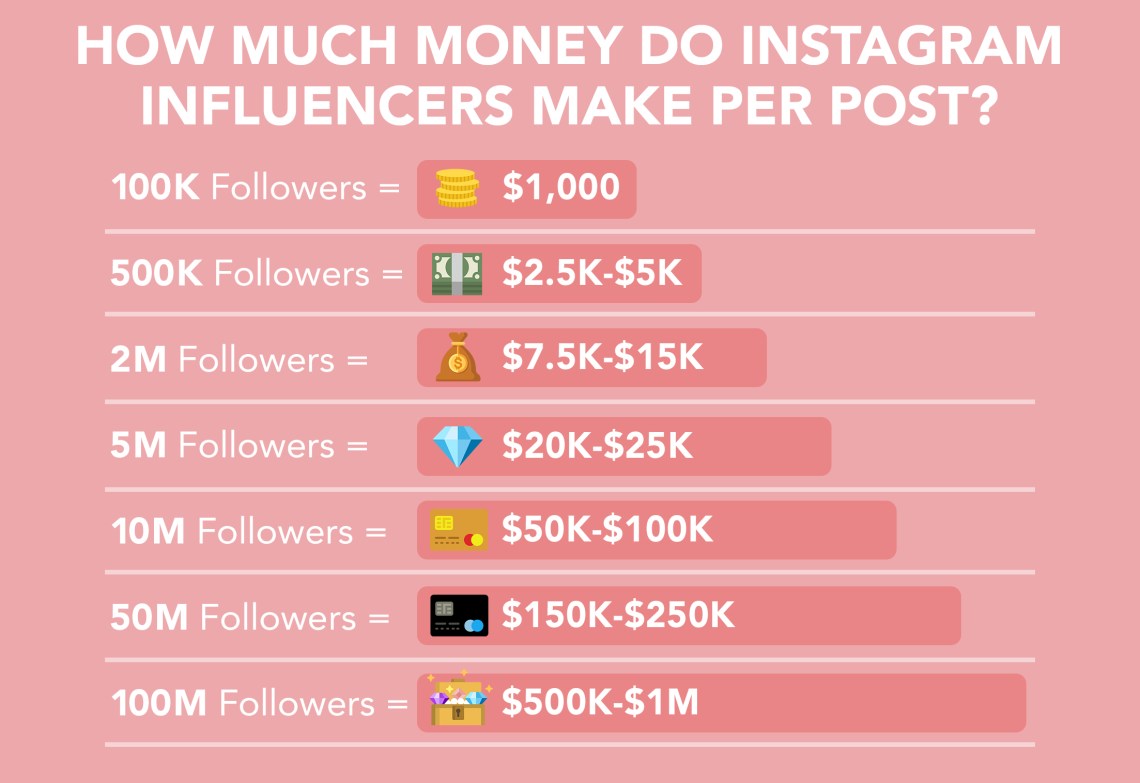
Activating a successful influencer marketing campaign:
1. Identify your target demographic.
2. Find the right influencer(s) to reach that target audience.
3. Work with your influencer partner(s) to build a narrative that’s both true to your brand, and true to theirs. It’s in a brand’s best interest if the content an influencer creates and posts endorsing a product authentically resonates with their audience.
4. Remember that influencer marketing, like all marketing, takes time. You need to convince would-be consumers that you are worthy of their attention, and, ultimately, their money.
What makes an influencer relevant to your brand?
An influencer’s core audience needs to align with your brand’s target demographic. Additionally, the main thing to keep in mind is whether an influencer’s audience is actively listening and taking action (in the form of likes, shares, replies, and comments) based on what they say or post.
Key factors for evaluating an influencer’s potential:
- Do they write / post about what your brand does or something related?
- Are they an expert in your industry?
- How many followers do they have?
- How engaged are their followers? How many likes / shares / comments do their posts generate?
- What type of consumer do they reach?
- Does their aesthetic / style fit with your brand’s?
- Are they already a fan of your company / brand or seem like they may be?
- Do they already work with brands?
- Do they require payment or are they willing to partner in exchange for complimentary products and / or services?
The ideal scenario is discovering an influencer who is already a fan of your brand, which means that their endorsement will truly resonate as authentic. But in most cases you will have to do some research and dig deeper to find the right influencer. Luckily, there are a lot of helpful tools for sourcing influencers.
How can brands effectively work with an influencer?
Identifying and partnering with an influencer is just part of the equation. You also have to decide on a strategy for your overall campaign. Below is a list of the different types of influencer marketing to consider:
- Takeover campaigns: An influencer is invited to takeover your brand’s social media account(s) for an agreed upon timeframe and use their own platform to cross-promote.
- Content sharing: An influencer shares brand-approved content on his or her own platforms.
- Branded hashtags: An influencer agrees to share content along with a caption including a pre-established hashtag.
- Giveaways: An influencer galvanizes their audience to participate in a contest and the prize is the brand’s product or service.
- Guest content: An influencer guest blogs on your brand’s website and promotes the content with linkbacks from their own platforms.
- Interviews / Q&A’s: An influencer provides an exclusive interview to your brand and cross-promotes it on their platforms.
- Livestreaming: An influencer livestreams their experience with your brand’s product or service at a designated time and place.
- Video series: An influencer weaves a product experience into a video that they publish on their platform.
- Reviews: An influencer reviews a product or service and advocates for it on their platforms.
- Expert opinions: An influencer taps into their expert status to endorse your brand’s product or service.
What are the regulatory requirements of influencer marketing?
As influencer marketing becomes more widespread, brands and influencers are being held more accountable. So expect more transparency requirements related to these partnerships. High-profile social media stars can no longer get away with promoting products through posts and videos without disclosing that they were paid. Bottom line? The FTC won’t tolerate sneaking ads in anymore.
To avoid legal troubles, you have to follow the FTC’s disclosure guidelines when working with an influencer. The premise behind the FTC’s endorsement policy is pretty simple: Make it clear that you’re compensating an influencer, and avoid any deceptive measures.
Here are some tips on best practices for influencers and brands based on current regulatory principles:
- Clearly disclose any financial relationship between a brand and an influencer.
- Make sure the sponsorship disclosure is nearly impossible to miss.
- Using #ad or #sponsored or a unique hashtag incorporating a brand’s name and the word “partner” (e.g. #[insertbrandname]_partner) in a caption is acceptable as long as the hashtag is clearly visible.
- Don’t rely on captions that require a user to click “more” to notice a disclosure.
- Treat sponsored tags like any other endorsement.
- On image centric platforms like Snapchat or Instagram Stories, superimpose disclosures over images.
- Built-in paid partnership features like the branded content option on Instagram and Facebook don’t necessarily meet FTC requirements, so disclose in the caption too.
If you have any additional questions, you can always email the FTC.
As a general rule, whether you’re a brand or an influencer, err on the side of over-disclosure. Make sure there is no doubt or confusion that sponsored content is what it is.
How do you measure the ROI of influencer marketing?
A successful influencer marketing campaign should support your overall marketing strategy and any measurable goals and KPIs. One of the challenges of influencer marketing is measuring its effectiveness. Aside from looking at sales generated and your bottom-line revenue, there are a few other metrics to consider.
Key ways to calculate the ROI of an influencer marketing campaign
- Growth in followers
- Growth in users / subscribers
- Traffic increases
- Social media buzz (likes, mentions, shares, comments)
Tips for making ROI easier to measure
- Create customized, trackable links using bitl.y or UTM codes so you can see how much traffic an influencer is driving.
- Monitor tracking parameters beyond traditional social media measures (likes / shares), which don’t always translate to conversions. For instance, track comments and hashtag action.
- Create a hashtag for your influencer that regular users can also use—maybe even in exchange for the opportunity to be featured on your brand’s account.
- Create personalized promotional codes for each influencer you work with.
- Build a unique landing page or a unique part of your brand’s site so you can isolate inbound traffic and attribute it to the influencer’s posts.
What are some examples of successful influencer marketing campaigns?
Case Study 1 —Youfoodz: The food company that reached millions through carefully selected influencers.
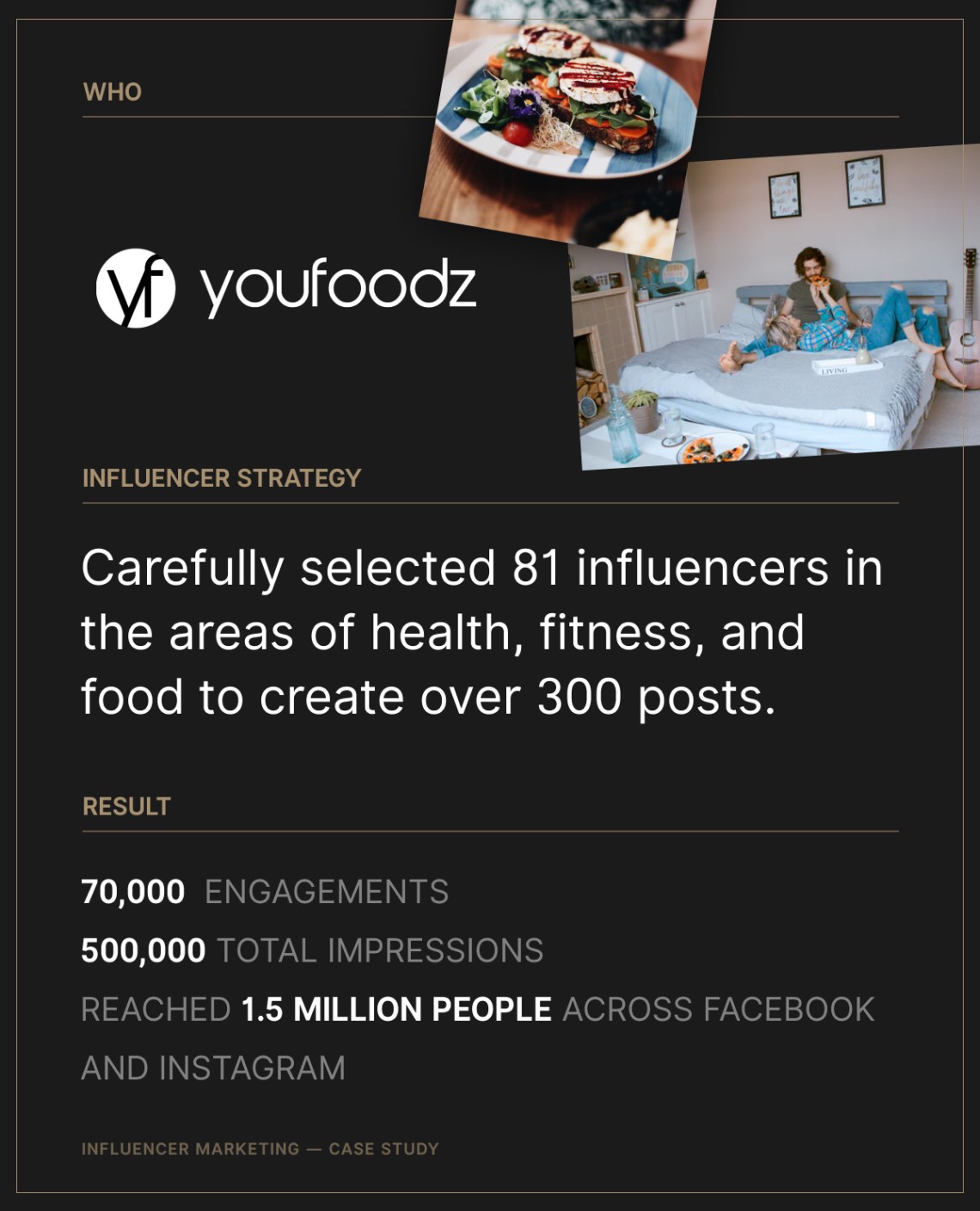
Youfoodz is an Australian fresh meal company that launched an influencer marketing campaign to promote their new winter menu. They identified 81 influencers in the areas of health, fitness, and food who created 167 pieces of content and over 160 Instagram Stories as part of the campaign. Here’s an example of a Youfoodz branded post by food blogger extraordinaire Jess Vuong. Youfoodz’s influencer marketing campaign generated 70,000 direct engagements and over 500,000 total impressions, reaching 1.5 million people total across Facebook and Instagram.
Case Study 2 — Daniel Wellington: The watch brand that sidestepped traditional advertising altogether.
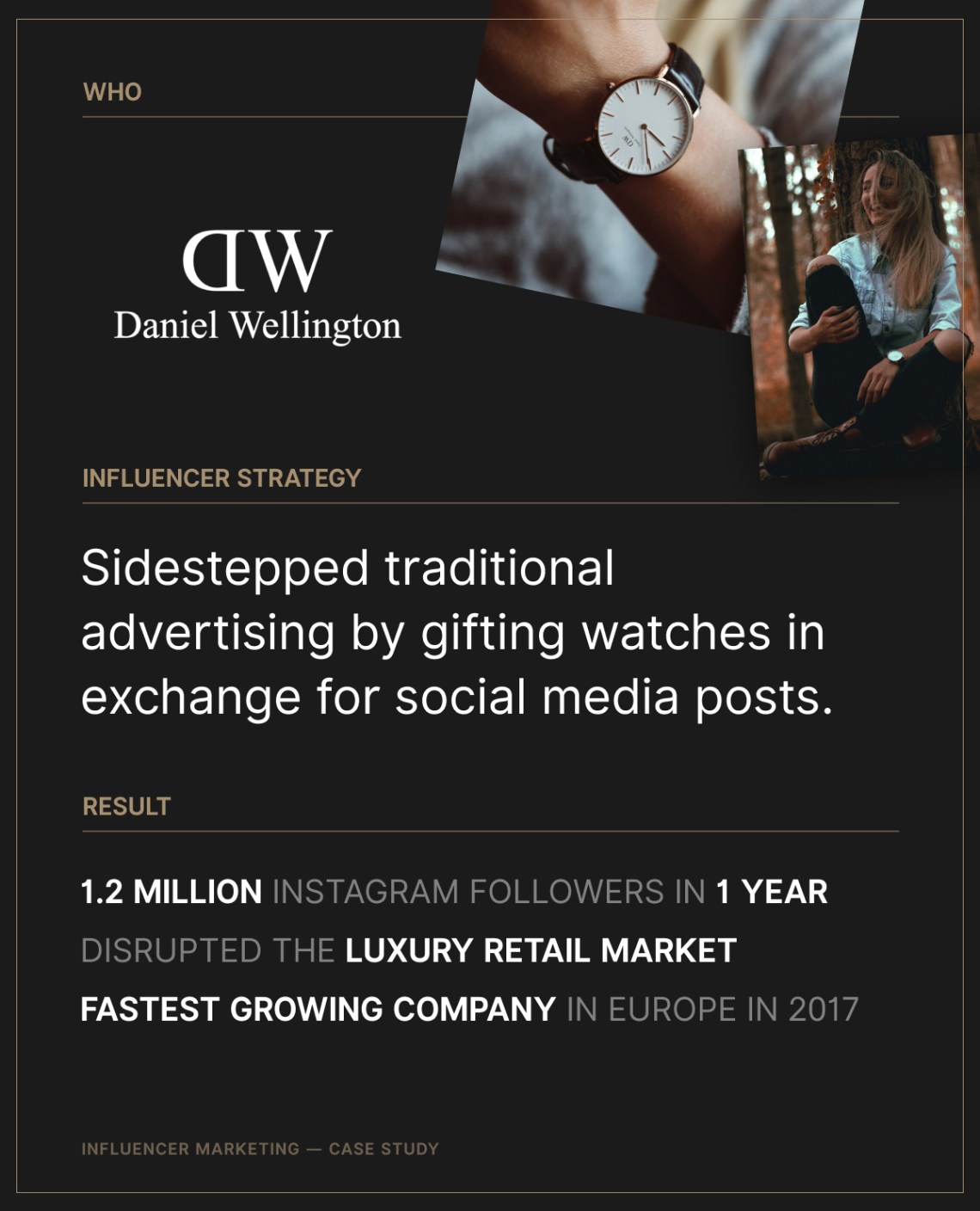
When 26 year-old Filip Tysander launched his direct-to-consumer watch company Daniel Wellington in 2011, he decided to forgo traditional marketing methods. Instead, the company focused on a digital first strategy, recruiting dozens of social media influencers to endorse their products. Often, they would gift one of their watches in exchange for a social media post. In a single year, they grew their Instagram account by 1.2 million followers and successfully disrupted the luxury retail market. By 2017, Daniel Wellington was named the fastest growing company in Europe, crediting their growth almost solely to influencer marketing.
Case Study 3 — Choice Hotels: The power of influencers sharing firsthand experiences
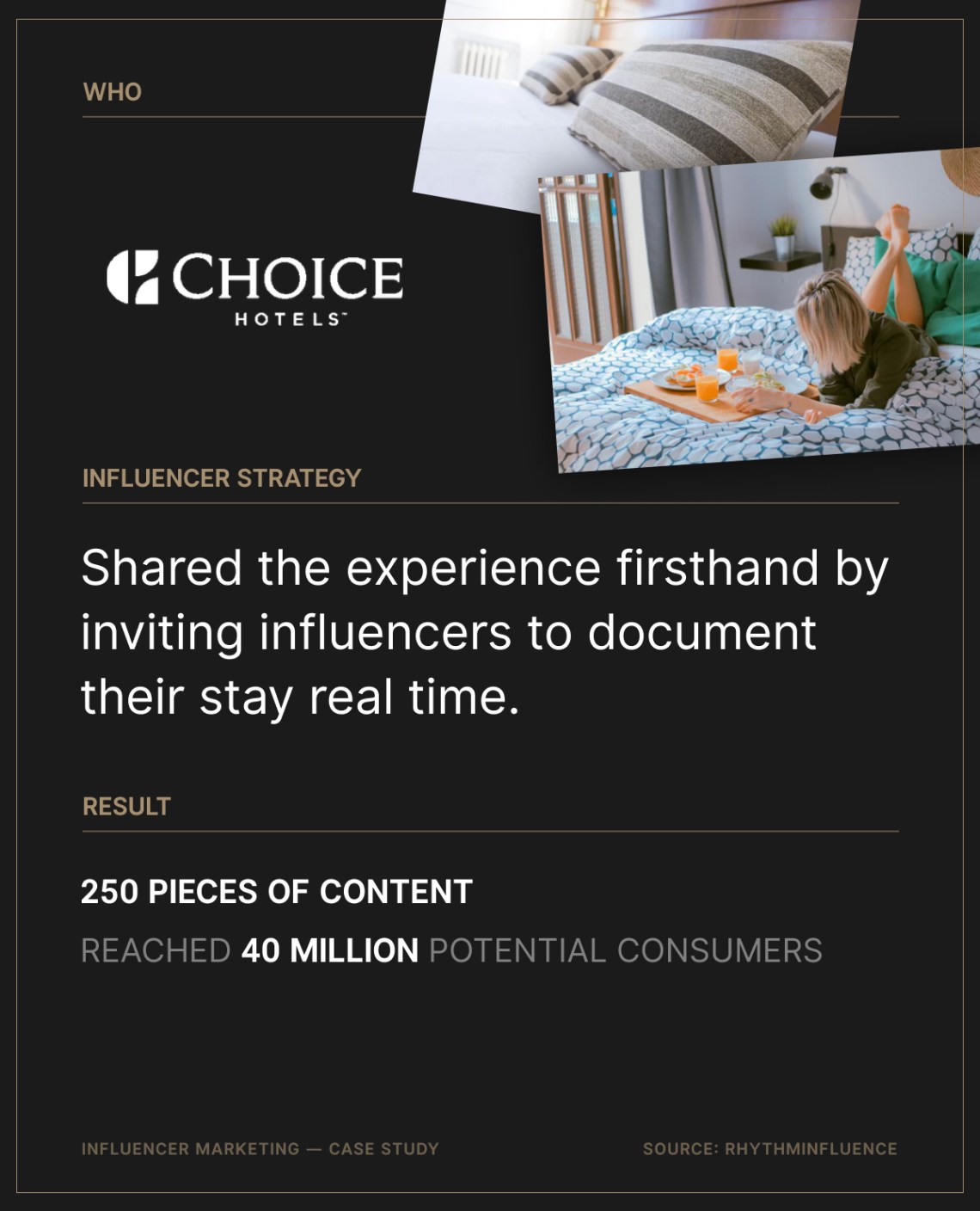
When Choice Hotels wanted to raise awareness for two of their brands (Cambria and Comfort Inn), they turned to the authenticity of influencer marketing. They selected influencers across categories, including mothers like Chelsea Foy. Each influencer was invited to a Choice Hotel property and asked to document their experience for their followers as authentically as possible in real time through videos, blog posts and photographs. Here’s an example of a detailed campaign post created by Foy on her popular blog. In sum, the influencers hired created over 250 pieces of content, reaching a combined 40 million potential consumers according to RhythmInfluence.
Case Study 4 — Thought Catalog: Influencer driven social media buzz leads to 800% spike in book sales.
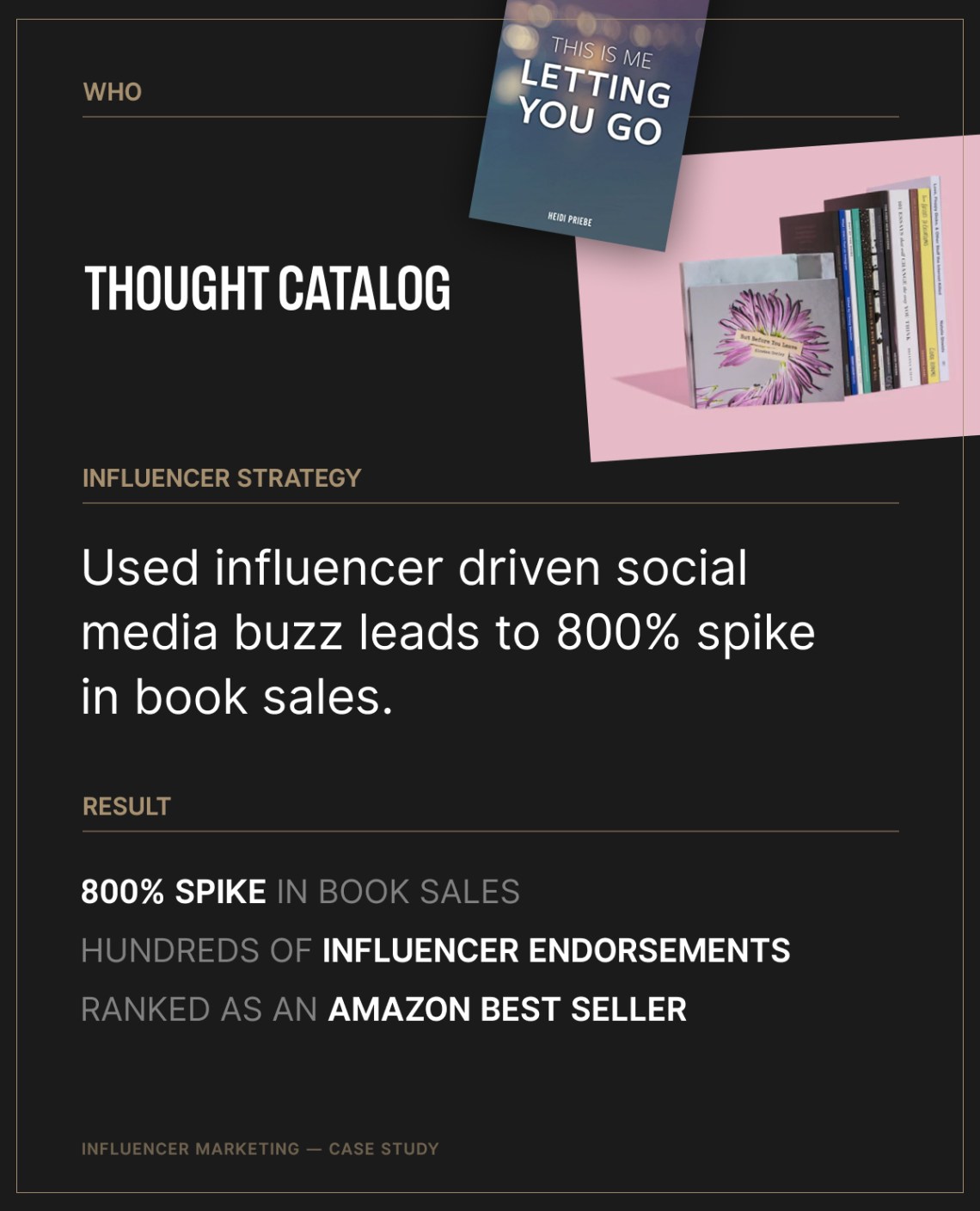
The following case study does not involve a deliberate influencer marketing campaign, but speaks to the effectiveness of organic influencer endorsements. In May of 2017, Thought Catalog’s book division noticed a spike in sales of one of its titles, This Is Me Letting You Go by Heidi Priebe. Within a single week, the book sold 800 percent more copies than usual. It was ranked as an Amazon Best Seller and hit the the #1 position in its category on Amazon.
How did this happen? The spike in sales was soon traced to a string of organic promotions by Instagram influencers. It all started with Poems Porn, an Instagram account with 1.9 million followers that excerpted the book in a post. Next, Instagram influencer Aimee Song (4.9 million followers) featured pages from the book in an Instagram Story. Shortly thereafter, Instagram Influencer Daddy Issues (4 million followers) bought the book and included it in an Instagram Story about what she was reading.
The spike in sales directly following authentic endorsements by multiple Instagram influencers was incredible. Everyone wins in this type of scenario, when a influencer promotes something they genuinely like. The influencers receive messages of gratitude from their fans, and the brand sees an increase in sales they can attribute directly to the social media buzz.
Case Study 5 — Paul Mitchell: Influencers hashtag haircare for a good cause.
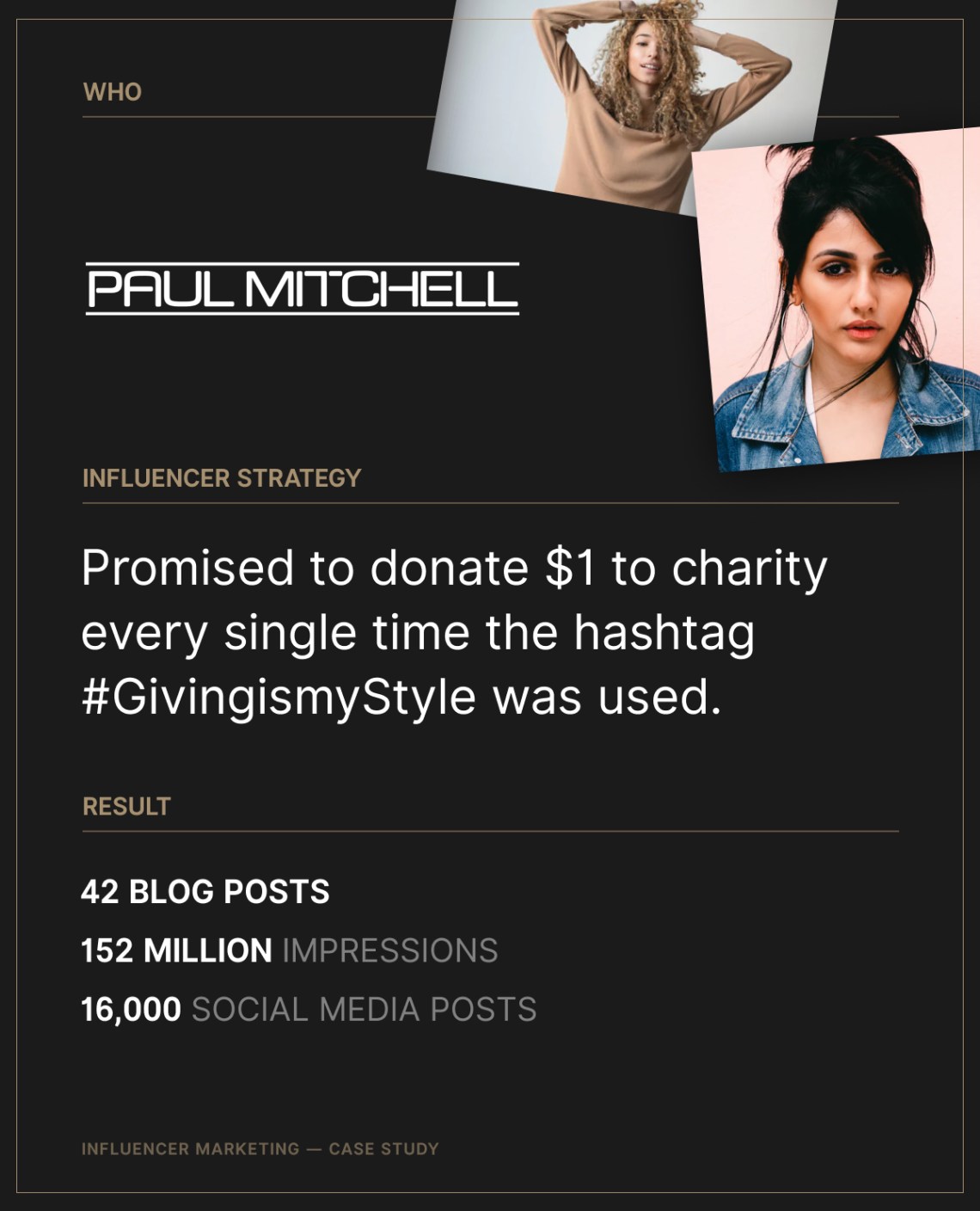
Haircare giant Paul Mitchell combined philanthropy and influencer marketing in a recent campaign. They established a hashtag #GivingismyStyle, and promised to donate $1 to charity every single time the hashtag was used. To get things rolling, they recruited several high-profile influencers who were asked to create content encouraging their followers to use the hashtag. Here’s an example of a call-to-action Tweet by blogger “mixed bag Ashley.” Overall, the campaign generated 42 promotional blog posts and 152 million impressions and over 16,000 related social media posts.
What does the rise of influencer marketing mean for the future of advertising?
The reality is that the old school, Mad Men style approach to advertising doesn’t work anymore. Instead of a small group of self-appointed “tastemakers” sitting behind desks making decisions about how to market a product, brands are realizing that it’s more effective to reach people through social media. When you’re vying for people’s attention, after all, the smartest approach is to go where people are spending their time naturally. Today, that place is the digital landscape, accessed primarily through mobile phones.
Without a doubt, the best way for brands to reach people on their smartphones is through influencer marketing—by partnering with individuals who have already established themselves on social media platforms. Why? Because people inherently trust the individuals they choose to follow on social networks. They wouldn’t be following them otherwise! When an influencer authentically advocates for a service or product, their audience listens. Not only that—they engage.
It’s simple, really. If you want to influence consumers, partner with individuals who have direct influence over them already.
The creative world is decentralizing, and it’s a beautiful thing for marketers that are ready to embrace the future. ![]()







